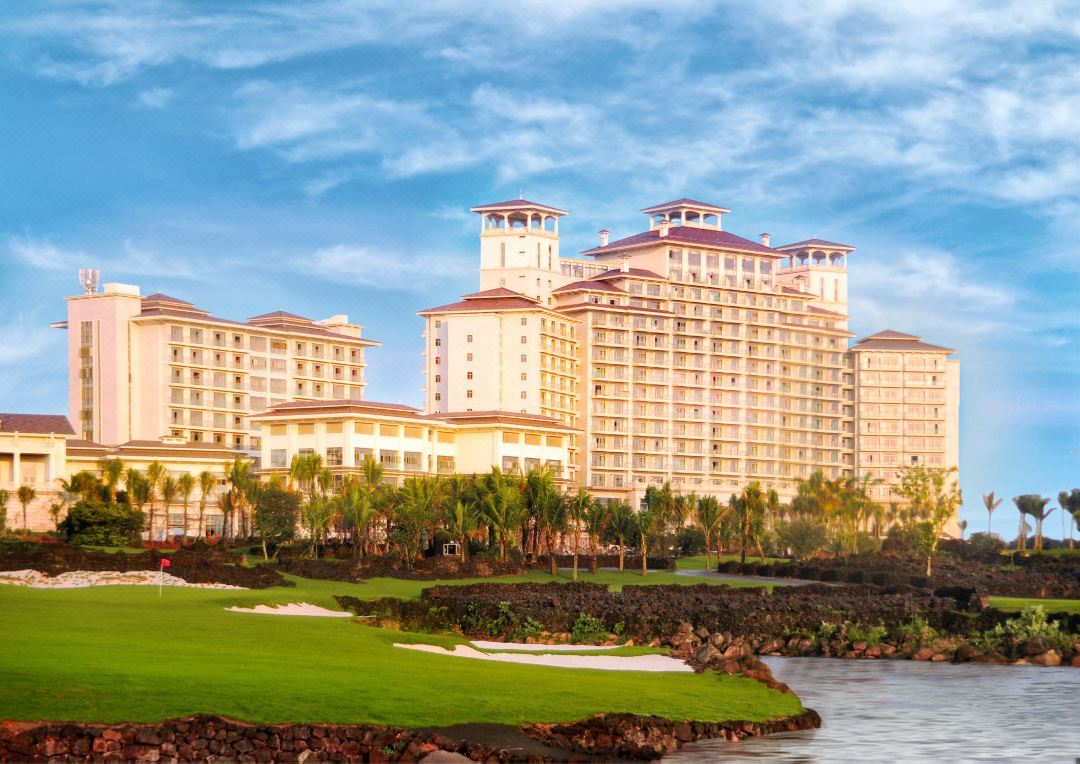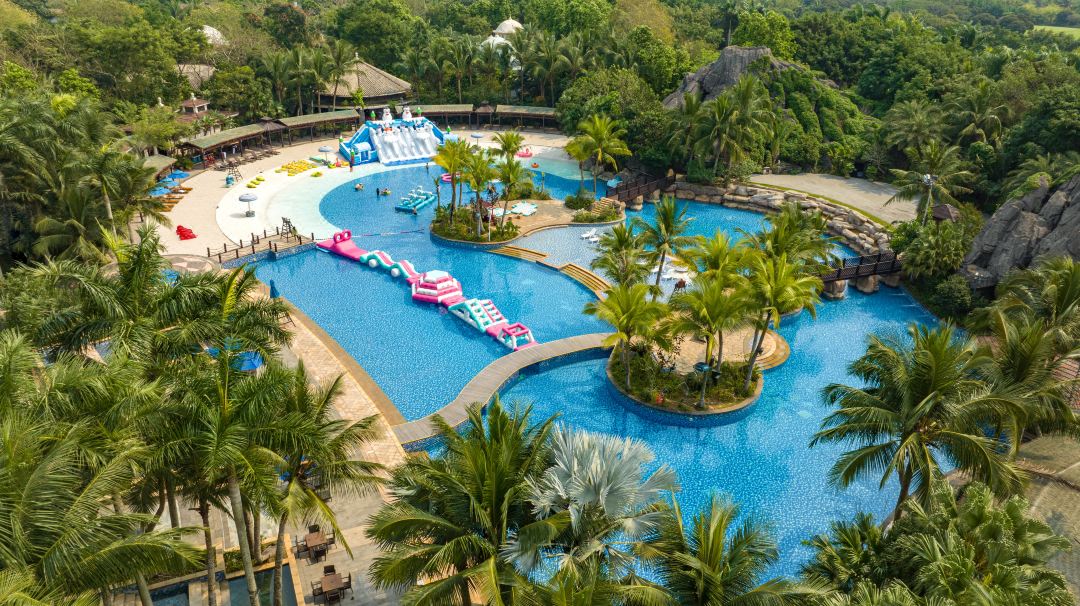Haikou Mission Hills
Mission Hills Haikou Golf Course No. 1 (Blackstone)
The crown jewel of the entire resort—the championship course. This pure golf course, free of residential areas, covers 350 acres and meanders through towering trees, dense jungle, and expansive lakes and wetlands.
A distinctive feature of the course is its volcanic rock surface, overlaid with soil transported from 25 miles away. The natural terrain has considerable elevation changes, and the designers paid close attention to “finding” holes within the original landscape, minimizing excavation while preserving the site’s beautiful lychee trees.
The volcanic rock base was considered a crucial element in the design process, as these natural stones create irregular boundaries between turf and rock, giving the course a style unlike most others.
Fairway contours harmonize with the surrounding scenery, emphasizing surface drainage to ease the burden on underground systems. The result is turf that looks like a magical carpet, with soft, irregular lines and no heavy rough areas—even bunker edges are grassed.
The original volcanic rock foundation, stone walls, and village relics are interwoven into the course, forming strong visual contrasts while preserving the memory of the site’s past.
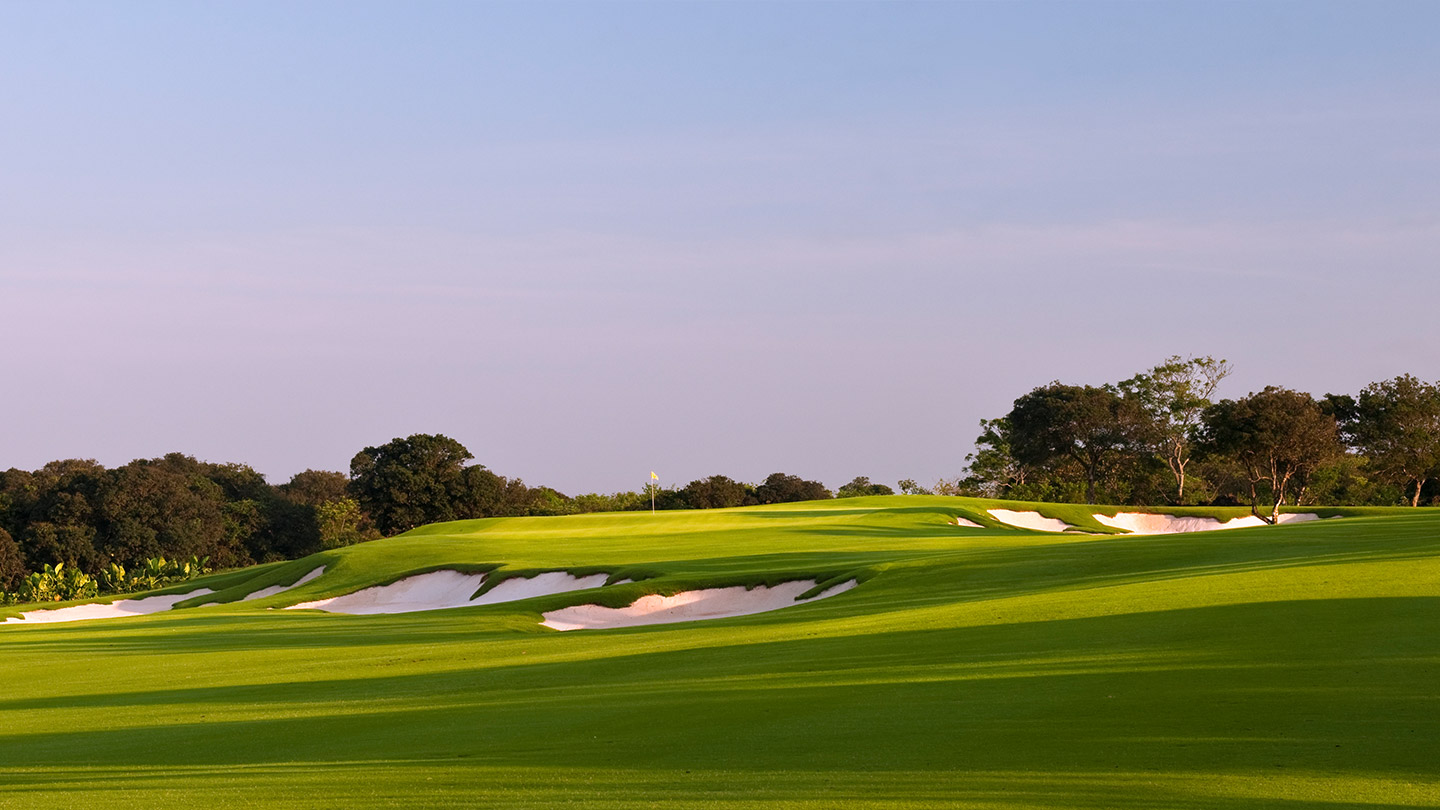
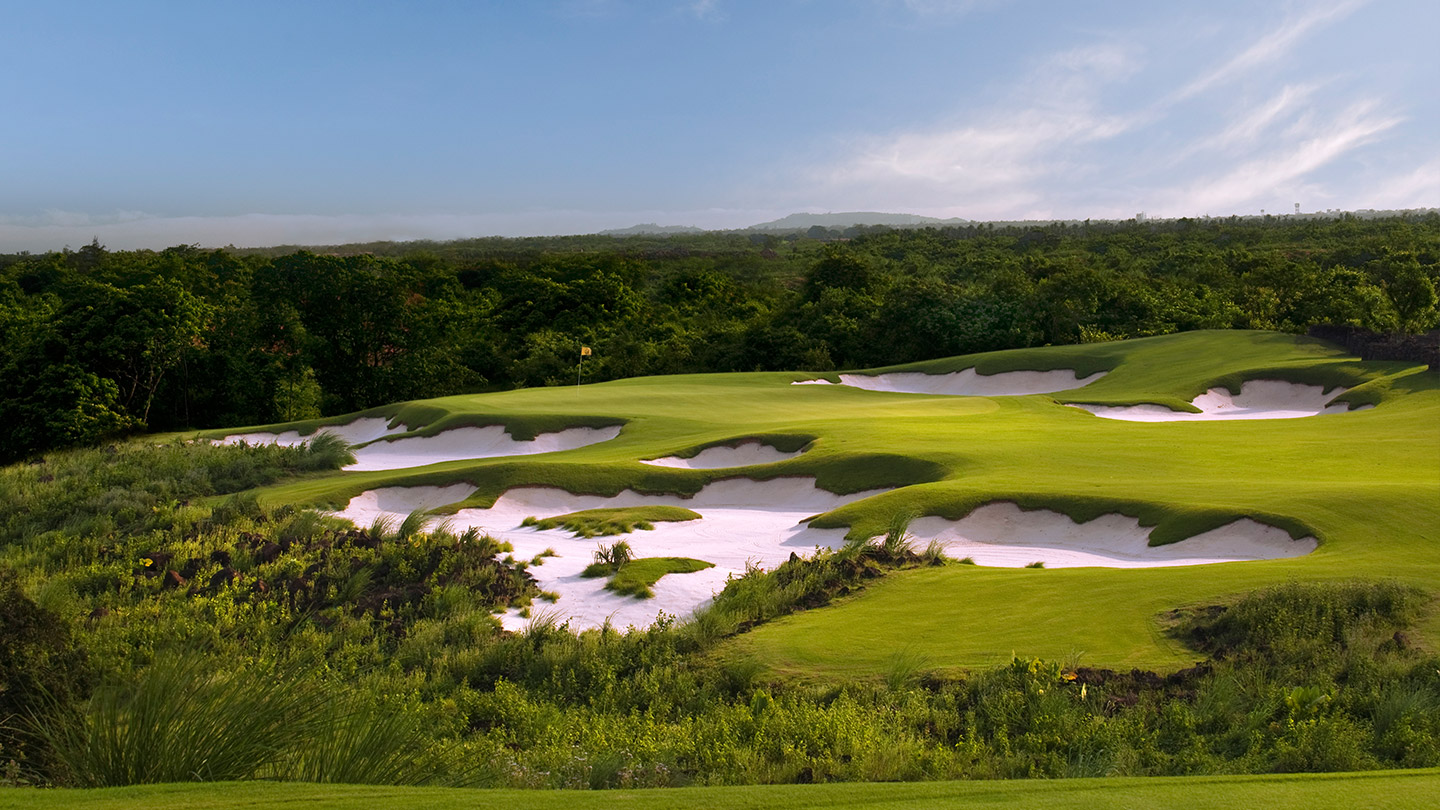
Mission Hills Haikou Golf Course No. 2 (Sandbelt)
The course resembles Melbourne’s Royal Golf Club, Kingston Heath, and the Metropolitan Club, with its defining features being large bunkers. The sand faces are high and undulating, with thick grass edges that stand noticeably higher than the fairways and greens.
Some bunkers are more formally shaped, surrounded by rounded grass edges, but where the bunkers transition into surrounding native areas, natural, irregular grass edges are used to strengthen the natural landscape.
The course also has large greens with significant surface undulations, and the tee boxes are square in shape.
The predominant tree species is eucalyptus, representing the distinctive Australian character.
The original terrain is gently rolling and sometimes flat, so during construction, sufficient turf areas were laid to ensure wide fairways and allow for multiple playing strategies.


Mission Hills Haikou Golf Course No. 3 (The Vintage)
The Vintage course was designed based on classic golf courses from the turn of the century. On one hand, the overall style of the course gives a natural impression, with fairways extending along the original terrain, allowing golfers to enjoy landscapes formed by many preserved trees.
At the same time, many artificial features adopt unusual shapes, sometimes geometric and eccentric. This reflects older traditions, similar to courses such as National Golf Links, Fishers Island, Maidstone, Chicago Golf Club, and Garden City, which inherited these historic characteristics.
The natural terrain is often combined with man-made elements such as raised mounds, deep bunkers, square greenside bunkers, ridge formations, blind spots, elongated bunkers, and large greens. The course successfully integrates these artificial features with the natural landscape.
The course covers over 250 acres, offering spacious grounds, abundant vegetation, and a layout that makes it comfortable for golfers to walk.


Mission Hills Haikou Golf Course No. 4 (Stepping Stone)
This is a short par-3 course, designed so that golfers strike directly onto the green in a single shot, followed by putting.
The fairways are encircled by volcanic rock formations and expansive bunkers, creating both challenge and visual drama.
The course is seamlessly integrated with the surrounding natural scenery, offering a unique experience that feels harmonious with the volcanic terrain and lush environment.


Mission Hills Haikou Golf Course No. 5 (Lava Field)
The Lava Field course shares many similarities with Course D and Course A, characterized by irregular fairway grass edges and rugged bunkers.
Its landscape is dominated by volcanic rock formations, with relatively few trees providing cover. The overall design emphasizes large-scale bunkers and dramatic black-stone scenery, a style rarely found elsewhere in the world.
The course stretches to a total length of 7,400 yards, making it fully capable of hosting major international tournaments.
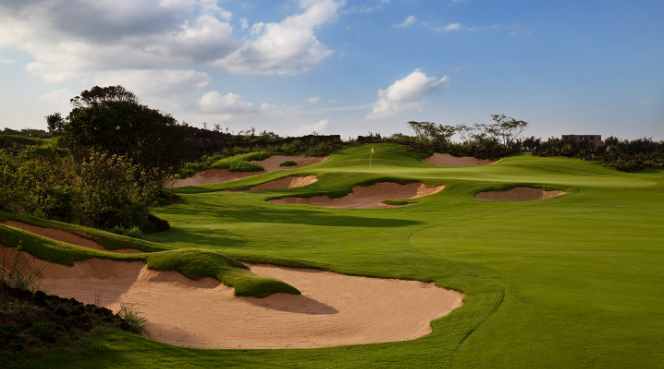

Mission Hills Haikou Golf Course No. 6 (Meadow Links)
Designed with features of U.S. Open courses from the eastern United States. The bunkers and fairway contours are shaped with geometric lines, complemented by “church pew” bunkers, grass-faced bunkers, and native grasses that create a vast prairie-like feel, with occasional trees. The greens are large, adding to the challenge of putting.


Mission Hills Haikou Golf Course No. 7 (Stone Quarry)
A tribute to mentor Pete Dye, showcasing all the distinctive design features associated with his style. With railway sleepers, abrupt mounds, snow‑hill shaped hazards, vast waste bunkers, devilish small greens, and train‑car bridges, the course creates a unique landscape. These elements are woven into winding fairways, enhanced by ancient volcanic terrain, steep stone walls, and dense vegetation. The original scenery includes remnants of coal carts, railway tracks, and abandoned mining equipment. The course style is straightforward and athletic, demanding bold, powerful shots. Amid today’s trend of ultra‑long courses, it stands out as a friendly yet entertaining alternative.
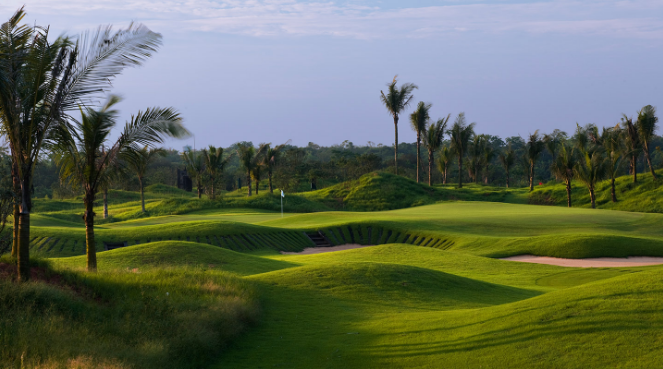

Mission Hills Haikou Golf Course No. 8 (Double Pin)
This par‑3 course consists of 18 holes, each green featuring two pins. One pin offers an easier, more accessible position, while the other presents a much greater challenge. Designed in a botanical garden style, the course is surrounded by diverse trees and flowers, harmonizing with Haikou’s blue skies and fresh air. Golfers of all skill levels—families, beginners, and professionals—can enjoy playing or practicing here and spend a delightful day.


Mission Hills Haikou Golf Course No. 9 (The Preserve)
Centered around lush palm groves, this course sets the tone as a beautiful, landscape‑style layout that is easy to play, with a distinctly modern design. Wide fairways are punctuated by bunkers, while greens are surrounded by mounds and shaped according to modern principles. Colorful flowering shrubs and groundcover plants create vivid scenery throughout the course, while the palm trees provide shade and a relaxed, comfortable atmosphere.


Mission Hills Haikou Golf Course No. 10 (Shadow Dunes)
This course immerses players in a “world of sand,” featuring towering dunes and local vegetation found along Hainan’s expansive beaches. It is not a beach course, but is distinguished by undulating contours and the resort’s largest greens. These wild green shapes can lead to daunting long putts, yet the course cannot be conquered by distance alone—precision in short putting is equally vital. Measuring about 6,600 yards with a par of 70, the close connection between tees and greens makes walking convenient and greatly reduces playing time.


Club Address
Mission Hills Haikou: No. 1 Guanlanhu Avenue, Longhua District, Haikou, Hainan Province
Tel: 0898‑6863388
Mission Hills Resort Haikou
The hotel is located amid the vast greenery of Guanlanhu Avenue, close to Feng Xiaogang Movie Town, Wet’n’Wild Water World, Teddy Bear Museum, and Guanlanhu New Town.
Accommodation: Over 500 guest rooms and suites, elegantly designed with scenic balconies overlooking the volcanic rock golf courses. The design blends Hainan cultural style with modern facilities, ensuring a comfortable stay.
Dining: Multiple restaurants offer Chinese and Western cuisine, with refined environments and diverse specialties, creating the feeling of a culinary journey around the world.
Hot Springs: The resort features volcanic mineral hot springs, sourced from 800 meters underground and formed by ancient eruptions. With 168 hot and cold pools and flowing landscapes, the springs incorporate spa traditions from five continents and hold a Guinness World Record.
Water Park: A 2,200㎡ water park includes outdoor swimming pools, an artificial beach, beach soccer and volleyball courts, and an outdoor performance stage.
Golf Courses: The resort boasts 10 volcanic rock 18‑hole golf courses, distinguished by black lava outcrops, ancient lychee trees, and stone walls, creating a lunar‑like atmosphere that offers golfers ultimate relaxation.
